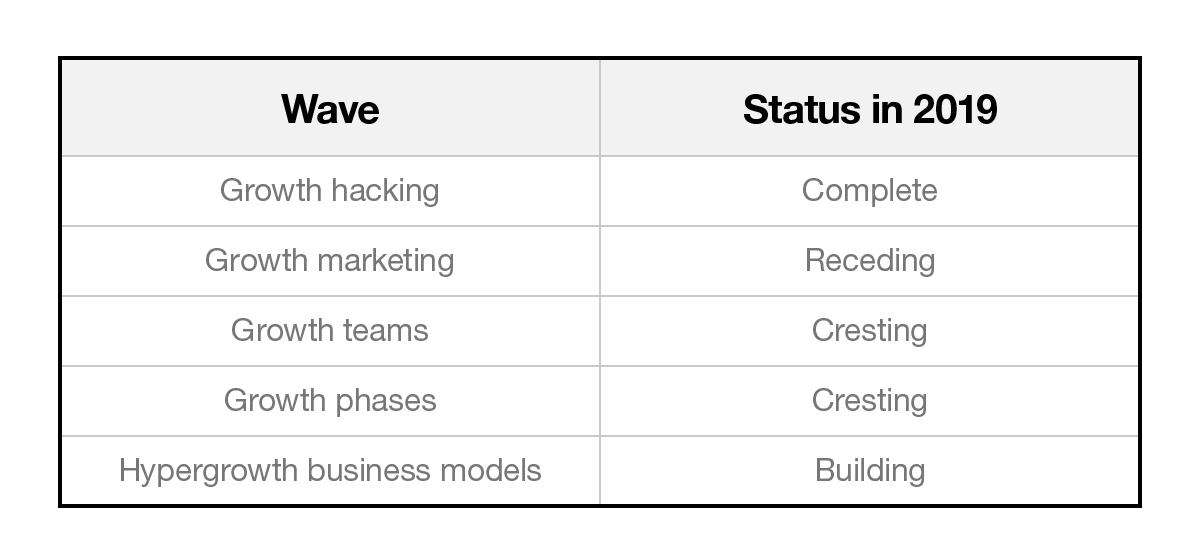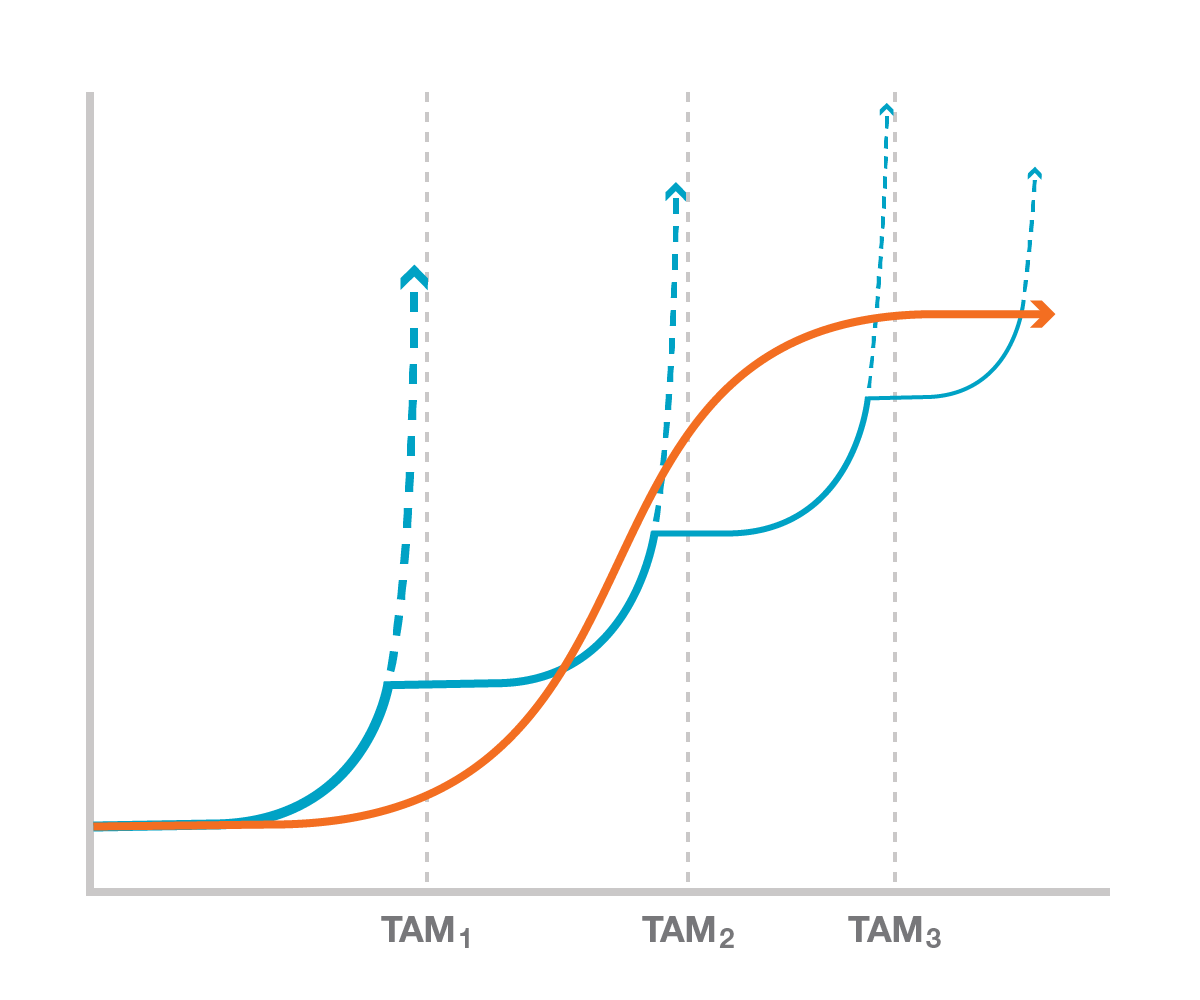Note: This article is part three in an ongoing series about growth.
The past twelve years have seen major changes in how Silicon Valley startups talk and think about growth.
Around the time of the 2007-2008 financial crash, a set of integrated technologies (mobile, wifi, cloud, open source, HTML 5) reached what Carlota Perez calls the Deployment phase of maturity, sparking a new, long boom of technological innovation and VC investment. The FANGA companies and their children—AirBnB and Uber, and dozens of SaaS startups—have been the most obvious beneficiaries and leaders of this new phase.
With this change in the hardware and software environment came a shift in language. “Innovation” suddenly was out; “growth” and “hypergrowth” were in. When the startup community talks about growth these days, they don’t typically mean growth-in-general, they mean the specific opportunities and practices associated with this new technological infrastructure. Within the startup ecosystem, Andrew Chen, Brian Balfour, and David Skok in particular have contributed detailed, nuanced thinking to this conversation.
In an earlier article, I shared my own take on how I see internal org structures evolving in the coming years as they continue to absorb these new technologies. In my general, future-state diagrams, there were no growth marketers, growth teams, growth designers, or growth hackers in sight.
This was deliberate. I think today’s proliferation of “growth” roles and titles is part of a genuine and important transformation but one that is still in progress. As these waves crest and alter the landscape, we will be left with org structures that assume and facilitate ongoing growth rather than restrict it to certain individuals, teams, or moments in an organization’s history.
My prediction, in short:
The new “growth” thinking will become a pervasive and assumed part of all product, relationship, and operational strategy—across industries and sectors—but in doing so it will cease to be an independent or unique skill set.
“Growth” will thus join a long lineage of successful management paradigms. As I wrote a few years back:
“[Art Kleiner in The Age of Heretics] describes an almost-linear progression of 20th century heretical ideas— from balanced scorecard and scenario planning to quality management and lean manufacturing to re-engineering and knowledge management— each of which was absorbed, metabolized, bastardized, and discarded by the general business culture… These ideas are all worthy, but what’s notable of course is that they all have expiration dates. Once the intended clients have grokked the essential concept, and incorporated it… there’s nothing for an idea-centered consulting firm left to sell, perhaps other than simple training.”
Before we write the epitaph for hypergrowth, however, let’s look at what it has contributed and is still contributing. From my perspective, the new thinking around “growth” has emerged in several distinct, overlapping waves:
Let’s look at each of these one by one.
1. Growth hacking
Following the 2007-2008 financial crash, a general ethos emerged in Silicon Valley that the best way to work with and within the new media ecologies was to iteratively test small experiments and then scale the successes. Sean Ellis, Tim Ferris, agile development practitioners, the chaos engineering movement, Lean Startup, and design thinking all came to this conclusion at essentially the same time.
The trend became dominant, and in doing so, ended. Growth hacking became the default paradigm for managing data-driven hypothesis testing in a VUCA environment. For example, today a “growth hacking” mentality is implicitly woven into all digital marketing, online attention arbitrage, evidence-based social sector work, and AI-related product development. Growth hacking in 2019 is neither a formal role nor an Area of Responsibility: it’s just a general job expectation.
Five years ago, Mark Suster wrote a good article summarizing the debate at the time as to whether growth hacking was really a “thing.” Depending on your perspective, everyone involved in this conversation either lost the debate, or won it: good growth hackers must understand marketing in general or else they make painful errors, and good marketers must understand growth hacking or else their skills aren’t contemporary.
Growth hacking is dead. Long live growth hacking.
2. Growth marketing
“Growth marketing” has been a stronger and more enduring wave than growth hacking. “Growth marketer” jobs today are everywhere and in high demand.
Definitions vary, but in general growth marketing involves hypothesis-testing new product ideas and customer funnel refinements to (a) increase short-term sales and retention and (b) inspire new, sustainable business models. Growth marketing, in a way, is “growth hacking” grown up and turned into a repeatable playbook and driver of strategic advantage.
Growth marketing was at first highly associated with two specific GTM strategies: (1) low-touch acquisition at the top of the funnel and (2) built-in virality at the bottom of the funnel. Self-service, freemium SaaS products understandably have been the big winners and drivers of the “growth marketing” trend—Dropbox and Slack are just two of many, many examples. Once this marketing/product handshake or “growth loop” is figured out, it is easy to scale it quickly.
And yet…
If growth marketing sits at the intersection of Product and Marketing, how is it different from just product marketing? My belief is that there is no difference. There’s only one skill, one discipline here.
Freemium SaaS companies and their investors have driven the grittiest, most repeatable playbooks related to growth marketing, but its lessons are applicable and urgent to businesses of all kinds, sizes, and GTM strategies, since we all share the same economic and technological context. For example, the NYT recently profiled symphony conductor and composer Esa-Pekka Salonen and his ideas for shaking up the current programming and distribution of live classical music… connecting this “product” to audiences and donors in new ways, with new business models, in the current economy and mediasphere, with real-time feedback loops.
Sounds like growth marketing to me.
At this point, growth marketing and product marketing—no matter what we call them—are essentially the same thing.
3. Growth teams
It’s become common these days in Silicon Valley to have designated “growth” teams. I have seen many variations, including:
- Independent units within Product
- Independent units within Marketing/Sales
- Independent units that bridge Product and Marketing
- Independent units that run entirely separate funnels
- Separate business units
Notice that a pattern is repeating here. First, across companies, “growth” heretics emerged, advocating for a new way of doing things. Now, within companies, growth teams are being established to incubate and leverage these heretical ideas. This is how new thinking often spreads. Creating a separate, designated team is the typical and probably necessary first step whenever a business finds it must disrupt itself to survive.
This first step though is never the last. GM eventually re-absorbed Saturn; the instantiation of DevOps overwrote legacy job descriptions for both Dev and Ops; acquired companies infect their host parents and then subtly or not-so-subtly change them. It’s unsustainable long-term for a company to have disjointed or adversarial internal teams, not because it’s uncomfortable but because it’s inefficient. As corporations get very large, they develop strategies for balancing conflicting priorities. The stepwise progression is always from separation to synergy.
If you have a Growth team today, fantastic—that might be just what you need. Here though is how that team will likely evolve, as you evolve:
- A sub-functional Growth team within a larger function—e.g., a “Growth SEO” team within a larger SEO team—will over time merge back into the SEO team as internal processes and tools related to SEO get more efficient, and as arbitrage opportunities related to SEO become harder to find.
- A Growth task force made up of cross-functional leaders will become indistinguishable from the leadership team itself.
- A Growth team that is effectively playing the role of Product Marketing will take over Product Marketing or merge into it.
- A Growth team running an independent funnel will either become a separate business unit or absorb the legacy funnel team. Penetrating new markets often involves important synergies with existing markets, and having duplicative resources spread across multiple funnels is often operationally unsustainable.
- A Growth team that functions as an ongoing incubator for new thinking will slowly become indistinguishable from R&D, a center of excellence, or some other standard entity that in today’s large organizations already plays this role.
SaaS tools like JIRA, Asana, Slack, Airtable, and zillions of others make it very easy to atomize tasks, each of which theoretically can then be handled by an optimally allocated, precariat specialist. But over time, an army of specialists requires a higher allocation of management oversight, and any task that’s purely executional can eventually be codified as a process if not automated away. When new roles and teams proliferate within an organization, there is usually soon after a culling. Decentralization is a precursor to centralization.
“Growth” teams can be essential in the short term, but they are not permanent structures.
4. Growth phases
The so-called “growth phase” of a startup can be a source of great excitement. The organization is succeeding and scaling, huge piles of money are showing up, the team is rapidly expanding, and a big payout is on the (long-term) horizon.
Hockey stick growth, however, is also a strong signal that an organization must begin disrupting itself and creating an engine to go after a new and bigger TAM. In today’s competitive markets, Product Market Fit is becoming a day-to-day ground war, not a watershed moment. Early-stage investment is getting more complex and complicated. The overall economy is a bit frightening. In other words, the exponential growth curve crashes back into the sigmoidal one pretty quickly.
If you’re fortunate to be at a stage of organizational growth where you’re suddenly hiring new people, building new systems, chucking old ones, and raising your visibility, this is all new and a strain on attentional resources… but also entirely expected. It’s like childrearing or marriage… it’s only bewildering if you haven’t been there before, or had unrealistic expectations.
I usually choose to believe that there is no spoon (i.e., hockey stick). There’s just work that gets increasingly complex and complicated. Treating this phase as enchanted or unusually stressful is often less productive that adopting Jeff Bezos’s mindset that every day is “Day One.”
5. Hypergrowth business models
In this article, I’ve suggested that most trends related to “growth” are either cresting or receding. But there’s one particular wave left, and although it’s been building for a long time, I suspect it’s just getting started.
Way back in 2006, Umair Haque wrote frequently and intelligently about the differences between networks, communities, and markets:
- Networks scale as a function of the number of nodes in the network. They thus tend to grow very fast. Facebook and Google both started as networks, and many SaaS businesses grew quickly due to network effects. It’s relatively easy to layer communities and marketplaces on top of networks, as both Google and Facebook have done.
- Communities scale as a function of the size and depth of the conversation. They thus scale more slowly than a network, and are more difficult to maintain. Digital communities create noteworthy social value—Wikipedia, Reddit, 4chan, Twitter, Second Life (RIP), Quora—but so far, limited economic value for the private sector company that creates them. This no doubt is due in part to the slower growth rate.
- Marketplaces scale as a function of the number of buyers and sellers in the market. Many successes of the Web 1.0 and Web 2.0 eras like AdWords, Amazon, iTunes, and eBay were marketplaces, as are the leading companies of our current era: Uber, AirBnB, Lyft, etc.
Networks and marketplaces have business models that inherently lead to hypergrowth. It feels like everyone got the memo a decade ago with regards to networks, but there is enormous untapped potential in marketplaces. Andrew Chen in the past month, for example, has been writing passionately about the future potential of marketplaces. And the intense, widespread VC interest in crypto is in part driven by the desire to create new marketplaces… and also to finish installing and deploying a next-gen layer of technological infrastructure that can inspire a new boom of innovation and creativity.
Hypergrowth startups can have negative social consequences. Marketplaces built by the private sector are concerning because they disrupt existing businesses and ways of life so quickly, and because the house always wins: the company (whether it’s Uber, Amazon, or eBay) privatizes a significant percentage of the gains to the detriment of the buyers and sellers on the platform. This is intrinsic to how capitalism works. Rather than expecting these companies to police the ingrained consequences of their business models, society and the political system must ensure that all the companies of the hypergrowth era are appropriately taxed and regulated.
Although marketplaces are changing our lives and our communities in sometimes-scary ways, they still hold bright promise. The book Radical Markets by Eric Posner and E. Glen Weyl, for example, is full of intriguing ideas for how marketplaces could be applied ambitiously to property rights, democratic voting, cross-border migration, data ownership, and other complex challenges in ways that could be socially positive and revolutionary.
Regardless your sector, org size, or political views—or whether you’re an investor, entrepreneur, citizen, or worker—there’s still time and reason (potentially) to be excited about hypergrowth.
Next article: Growing up





Leave a Reply